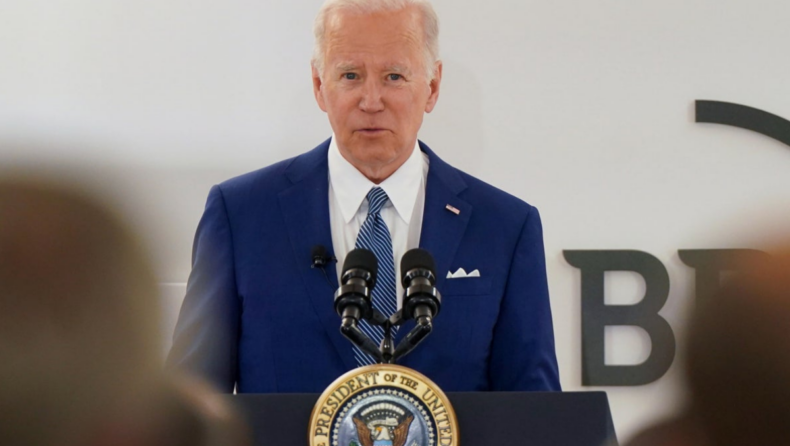Noting how India was an “exception” amongst all its allies who responded to the Russia’s invasion of Ukraine in a unified, concerted, and strong manner, the US President Joe Biden observed that India stood on shaky grounds not only while dealing with Putin’s aggression but also in actively vocalizing their protest in that regard.
Addressing a business roundtable of 16 CEOs from various sectors to apprise the industry of the latest developments on the crisis and discuss the way ahead, Biden stated that the Quadrilateral Security Dialogue (QUAD), with the possible exception of India being somewhat shaky, has otherwise been extremely strong, with Japan and Australia standing firm in dealing with Russia.
Earlier, India had also refused to join votes condemning Russia at the United Nations, underlining its close ties with Moscow.
Reportedly, until last month, India and the US were trying to resolve their differences diplomatically on the issue of Russian aggression against its pro-West neighbor, which has now entered its 27th day.
The ongoing war in Ukraine has diverted the world’s attention to Eurasian politics, for the moment eclipsing the ever-volatile Indo-Pacific.
The situation is extremely vulnerable in Ukraine, with essential supplies and services disrupted and thousands fleeing, as the Russian advance becomes more “brutal” and Russian nuclear forces are reportedly on high alert.
The scale of displacement is “one of the biggest” within Europe since the Balkan wars. Yet there is no end in sight at the moment, though ceasefire talks have begun and the United Nations has raised about $1.5 billion for emergency humanitarian assistance.
The U.N. General Assembly’s 11th emergency session adopted a resolution demanding that Russia immediately end its invasion of Ukraine and unconditionally withdraws all its military forces.
However, the measure seemed more symbolic than effective. The Asian powers, India and China, again chose to abstain: China’s official view takes into account “the history and complexity of the current crisis” and “the principle of indivisible security,” at the heart of which lie the eastward expansion of the North Atlantic Treaty Organization (NATO) and similar crises in its own backyard.
India’s “Explanation of Vote,” on the other hand, rests on “the totality of the evolving situation,” and said that the nation’s biggest priority is the evacuation of the stranded Indian nationals.
At the same time, India has reiterated its “commitment to the principles of the U.N. Charter, to international law and respect for sovereignty and territorial integrity of all states” and dispatched relief and medical supplies to war-hit Ukraine.
Though India’s cautious stance is being seen as tacit support of Russia, its primary focus is navigating the hardened Western response to Russia’s military advance and not abandoning Russia, a key historical ally. It needs both sides to contain the growing belligerence in its own neighborhood.
But does the Ukraine-Russia conflict really test India’s foreign policy resilience? What are the complications outlining India’s restraint? Will it affect India’s efforts to engage with Eurasia? Will India’s stance affect the growing synergy with the West, as well as the Quadrilateral Security Dialogue (Quad), in the Indo-Pacific?
Tacit Support: Historical Grounds and Neighborhood Quandaries
India shares a “special and privileged strategic partnership” with Russia, covering political understanding, strong defense cooperation, space partnership, and energy ties.
The close relations between the two nations date back to the Cold War era, especially in the 1970s when India signed the 20-year Treaty of Friendship with the Soviet Union (despite India being a founding member of the Non-Aligned Movement).
The Soviet Union supplied arms to India against Pakistan, which was being militarily supported by the United States. Over the years, Russia has been providing India with submarines, tanks, fighter jets, and even assistance to develop its nuclear program.
India-Russia bilateral trade amounted to only $8.1 billion (April 2020-March 2021), not high compared to India’s trade with United States or even the European Union, but their defense (and energy) ties are significant.
Russia remains India’s largest arms supplier, constituting about 49 percent of India’s arms imports during 2016-2020. In 2018, India signed a $5 billion deal for the procurement of Russian S-400 missile defense system, which has placed it under the shadow of Washington’s Countering America’s Adversaries Through Sanctions Act (CAATSA).
Undoubtedly, the West’s current sanctions on Russia and the dire situation in Ukraine will impact both the Ukrainian and Russian defense industries, which will have a trickle-down effect on India for an “indeterminate period.”
The repercussions will affect not just India’s ongoing projects with Russia, but also such deals as the recently signed $375 million BrahMos cruise missile defense contract between India and the Philippines, which requires vital components from Russia.
Further, the growing synergy between China and Russia in recent years has brought into the limelight the “Eurasian Order” construct. Putin’s “pivot to the East” policy put forward the largely (for now) rhetorical proposal for a “Greater Eurasian Partnership” with China, not only as a counter to the West but also to meet the growing Chinese influence in the Eurasian region via the Belt and Road Initiative.
In February, the two achieved a new “no forbidden areas” convergence in their relationship while outlining their ideas on democracy and “redistribution of power” in the world.
This anti-West alliance from two authoritarian states is worrisome for India, not only because of the threat to the existing rules-based global democratic order that India believes in, but primarily due to the potential impact of Russia coalescing with its two nuclear neighbors.
Russia’s growing engagement with Pakistan, such as via the $2.5 billion natural gas pipeline project, signed in 2021 and tentatively starting next year, in concert with China-Russia ties and India’s growing relationship with the U.S. to counter China in the Indo-Pacific, are significant points of departure.
Against this unstable scenario, New Delhi’s refusal to denounce Russia or support Western sanctions is not out of the ordinary.
Notwithstanding India’s strong historical and defense ties with Russia, the two diverge on many issues, especially on the Indo-Pacific construct and the Quad, which Russia sees as U.S. creations for pursuing “anti-China games.” India has, nonetheless, exhorted Russia as a “Pacific power with interests in the Indian Ocean” to “join the debate” on the Indo-Pacific.
Evolving Strategy on Eurasia
Eurasia is critical to Indian foreign policy, especially because of an increasingly influential China.
In recent years, India has engaged actively with the countries in the Eurasian region, besides Russia. However, India needs to formalize its strategy in Eurasia, like in the Indo-Pacific, amid the growing China-Russia convergence and with the geopolitics in the region being shaped by regional powers.
The ongoing crisis in Ukraine makes it even more urgent: The United States will rethink its strategic commitment to the region, as will the EU, which is already seeking strategic autonomy.
Here, India’s connections with Russia in multilateral fora such as the U.N. (where Russia has supported India’s bid for the UNSC and used its veto to support Indian interests), Shanghai Cooperation Organization (SCO), BRICS (Brazil-Russia-India-China-South Africa), and Russia-India-China (RIC) trilateral are a critical foreign policy tool, which, however, discourages India from being overtly anti-Russia.
Russia has appreciated India’s stand as “balanced and independent,” while Ukraine understandably is “deeply dissatisfied” and wants New Delhi to take a more proactive approach, given that Indian Prime Minister Narendra Modi and Russian President Vladimir Putin share a close relationship.
Certainly, New Delhi does not support the Russian invasion per se, primarily because it would provide indirect legitimacy to authoritarian tactics and question the viability of security mechanisms such as NATO, in turn legitimizing indirect support for Chinese military adventurism in India’s own backyard.
Hence, expressing solidarity with Ukraine, on whose behalf the world at large is morally outraged, is in line with India’s larger value-based principles, as well as its goal of pursuing greater partnership with Europe (particularly Central and Eastern Europe).
For this purpose, as it cannot decry Russian tactics, India has used diplomatic channels and humanitarian aid to reach out to the international community and the war-torn region, respectively.
Published by : Aditya Andharia
Edited By : Kritika Kashyap













